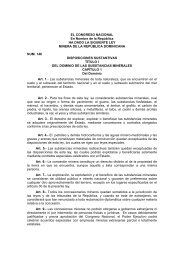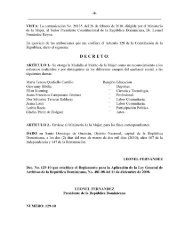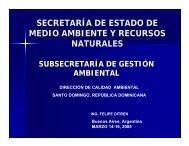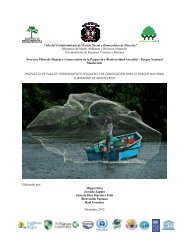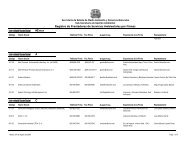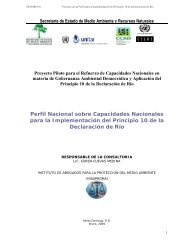CAMBIO CLIMATICO
CAMBIO CLIMATICO
CAMBIO CLIMATICO
You also want an ePaper? Increase the reach of your titles
YUMPU automatically turns print PDFs into web optimized ePapers that Google loves.
PRIMERA COMUNICACIÓN NACIONAL<br />
The adaptation measures in this sector should<br />
be in the form of specific actions at project,<br />
basin, or region levels, in order to efficiently<br />
respond to the particularities of the systems for<br />
which they are conceived. Also admissible are<br />
measures of regional scope in areas such as<br />
planning, as well as methodological or educational<br />
measures. An element to consider in the<br />
adaptation measures analysis is the importance<br />
of the sector in the functioning and development<br />
of the majority of environmental systems, economic<br />
sectors and society. The measures should<br />
be comprehensive, with benefits that will fulfill,<br />
to the greatest extent possible, the expectations<br />
of all the activities that interact with water.<br />
(Planos and Barros, 1999).<br />
Adaptation measures are usually costly, this<br />
being the most sensitive element to consider in<br />
their adoption, especially taking into account<br />
the level of uncertainty that exists in the magnitude<br />
of climate change. However, there are<br />
measures that are economically feasible, as they<br />
are useful from the first moment of application,<br />
and acceptable under any climate conditions.<br />
1.4.2 Coastal Marine Sector<br />
For the purposes of this report, the coastal zone<br />
will be understood as the geographic space that<br />
includes the interactive phase between the ocean<br />
and the land, as well as the interconnections of<br />
the ecosystems that are found in this space and<br />
the different socioeconomic activities directly<br />
related to it. Furthermore, throughout this<br />
report, the term Coastal Marine Zone (CMZ) will<br />
be used as a synonym of the coastal zone (CZ),<br />
to take note of the fact that both the marine and<br />
land areas form a functional unit.<br />
1.4.2.a) Sea-Level Rise<br />
The most obvious impact when one thinks of a<br />
rise in sea level is precisely the submersion of<br />
the lower coasts that will become totally covered.<br />
This coverage can have different implications<br />
according to the type of coast and the<br />
ecosystems that are developed, but it will be particularly<br />
impacting on those emerged coastal<br />
ecosystems where the influence of the dynamic<br />
factors such as tides and swells – that will<br />
inevitably be altered – have a more direct effect<br />
on its development. With a moderate rise in sea<br />
level, the impact, therefore, can be gradual and<br />
compensated by the evolution of the natural systems<br />
in so far as these can exhibit a high tolerance<br />
to the changing environment. However,<br />
with a higher temperature and a rapid rise, the<br />
impact can be catastrophic and can seriously<br />
alter the coastal morphology.<br />
The climatic scenarios of sea level rise that are<br />
used in the present report correspond to the<br />
global trend identified by the IPCC through the<br />
IS92 a-f scenarios.<br />
These sea-level rises, according to the specified<br />
scenarios, imply different annual rates of increment,<br />
which range from 0.12 to 0.14 cm/year for<br />
the IS92c, from 0.38 to 0.65 cm/year for the<br />
IS92a, and from 0.66 to 1.17 cm/year for the<br />
IS92f. It should be noted that in addition to the<br />
sea-level rise, it seems that an increase in the<br />
rate at which this occurs is also expected.<br />
1.4.2.b) Increase in Temperature<br />
For the definition of increased temperature<br />
scenarios, the series from 1961 to 1990 was<br />
used, for ten coastal provinces. Considering<br />
the results of the SCENGEN Model that subdivides<br />
the country into two cells and the differences<br />
that exist in the thermal pattern of the<br />
coast and the sea in the Atlantic and Caribbean<br />
slopes, four areas were differentiated in the<br />
interest of analyzing the effect of temperature<br />
on the coastal zone.<br />
Regarding the average values, the increments in<br />
the surface temperature of the water in the coastal<br />
zone indicate a difference DT (DT = Tpresent –<br />
Tperiod indicated), on the order of 2.144, 1.843,<br />
1.879, and 0.987 degrees C, for the areas of the<br />
Atlantic and Caribbean slopes, respectively, for the<br />
year 2100. This means that for a mid scenario, the<br />
temperature of the coastal water would range, on<br />
45



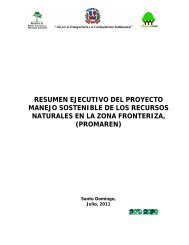
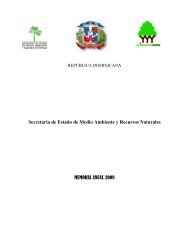

![Documento de trabajo del grupo G-77[1] EconomÃa verde en el ...](https://img.yumpu.com/50859069/1/190x245/documento-de-trabajo-del-grupo-g-771-economa-a-verde-en-el-.jpg?quality=85)




